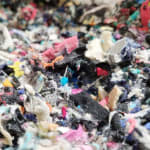
To this day, only a tiny fraction of discarded textiles is recycled. While the clothing industry has doubled production in the last 15 years, the time garments are worn has fallen by more than 30%. At the same time, the rising demand for low-cost fast fashion is driving a decline in the quality of the materials, which makes them more difficult to re-use or recycle. According to the Ellen MacArthur Foundation, it is estimated that 114 million tonnes of textile waste are generated every year. Of the clothing that is collected for recycling, 12% is downcycled into lower-value applications such as insulation material, and less than 1% is used to make new clothing in a closed-loop circular economy. The high content of polyester in fast fashion also means that an increasing quantity of discarded textiles are incinerated in waste-to-energy plants because of its high calorific value.
The environmental impact of textile waste
The rising consumption of clothing, coupled with the decreasing wearing time and increasing use of synthetic materials such as polyester and nylon, is worsening the negative impact on the environment. Large quantities of plastic microfibres shed through the washing of textiles are leaked into the ocean, accounting for 35% of microplastic pollution1. Improper disposal can also result in flat textiles released into the environment, endangering wildlife on land2 and marine life3.Regulatory drive for the development of textile recycling
Policymakers have a key role to play in driving an increase in recycling. In Europe, in 2022 the Commission presented an EU Strategy for Sustainable Textiles4, which includes extending the lifetime of textiles by recycling the materials they contain into new quality products. The revised Waste Framework Directive requires EU member countries to establish systems for separate collection of textile waste by the beginning of 2025, and at the same time, new collection and recycling targets will kick in. The infrastructure for collecting, sorting and recycling these materials will need to expand fast in readiness for the new regulations.

The textile sorting challenge
Clothing is made of different fabrics, fixtures and accessories, such as buttons or zips, and they contain a variety of raw materials – combinations of natural and synthetic fibres, plastics and metals. This makes disposing of it sustainably a complicated matter.
“The recycling industry requires pure fractions or very specific mixtures,” explains Annika Ludes, Engineer for Digital Solutions at Stadler. “This means removing the fixtures and accessories from the fabric. The different materials in the garment – the outside fabric, the lining, the seams – need to be separated, then the different fibres in each fabric (cotton, elastane, polyester, etc.) must be sorted.”
Today, textile sorting is done manually, and only a small portion of the output material is suitable for recycling. However, research is ongoing on automating the process with the aim of producing the high-quality fractions required to address the recycling challenge.



